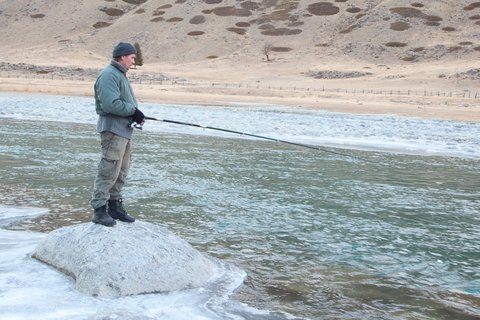Fly fishing for trout in the winter forces anglers to adjust their approach and re-examine the techniques they typically use, due to the unique conditions of the streams.
In order to catch trout consistently during the winter, you need to follow a proven plan. Here are four ways you can improve your winter fly-fishing success.
GO SLOW
In most cases, the water temperature of trout streams during the winter is hovering in the 30s, maybe the 40s. This slows the metabolism of the fish and they are unwilling to move far or fast to take your offering. In order to compensate, anglers must slow down, in a variety of ways.
First of all, winter trout streams tend to be crystal clear, meaning it is easier to spook wary trout. As you move along the bank, move slowly to avoid detection. Stay low and try to avoid crunching snow or breaking ice along the shore – any noises that my scare the fish.
Going slow also applies to the act of fishing. Work your flies slowly and methodically through each location, giving the sluggish fish plenty of opportunity to see and take your offering.
You should also slow down when it comes to casting. Wait longer between each cast to give the fish a chance to recover from anything that may have startled them during your last cast.
DRAB IS GOOD
Nymphs are the go-to flies in winter fishing, but whatever type of fly you choose, keep the colors drab and earthy. Stay away from flash and sparkle, even with the bead heads on your nymphs. The best winter colors are blacks, browns and earthy greens.
Drab should also apply to your clothing. Stick with blacks and browns to help you blend in with your surroundings, to avoid spooking fish.
STAY LITE
Since most streams are crystal clear and low during the winter, you need to go lite when it comes to your tippet, to help you avoid scaring the trout. Whatever size tippet you use during the spring or summer, drop it down at least one size. You may also want to consider using a longer leader. In addition, try to avoid strike indicators or use indicators that are less visible.
PLAN AHEAD
Since the trout streams are low and clear, it can be easier to spot trout in the water than at other times of the year. It is also easier to scare the fish. With this in mind, as you approach each location, try to scout it from a high location, away from the stream bank. Identify where the fish are located, so you can make more targeted, efficient casts. When you know the location of the fish, you are able to select locations to cast to, which are upstream from the fish. This will reduce the chances of casting right on top of the fish and scaring them, which will drastically reduce your odds of success.








